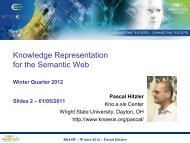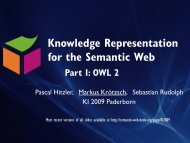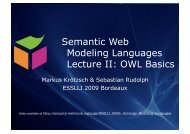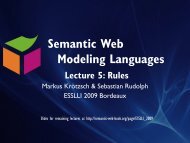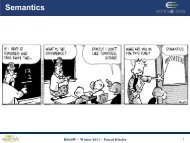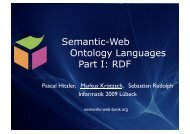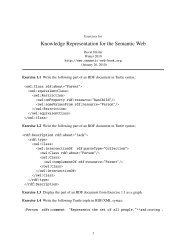Part II: OWL - Foundations of Semantic Web Technologies
Part II: OWL - Foundations of Semantic Web Technologies
Part II: OWL - Foundations of Semantic Web Technologies
You also want an ePaper? Increase the reach of your titles
YUMPU automatically turns print PDFs into web optimized ePapers that Google loves.
<strong>Semantic</strong> <strong>Web</strong> Modelling Languages<br />
(<strong>Part</strong> 2)<br />
Tutorial at IJCAI-09<br />
July 13, 2009<br />
... actually moving to Wright State University, Dayton, OH, Sept. 2009<br />
Pascal Hitzler<br />
AIFB, Universität Karlsruhe (TH)<br />
Germany<br />
Markus Krötzsch<br />
Sebastian Rudolph<br />
http://www.pascal-hitzler.de<br />
http://korrekt.org<br />
http://www.sebastian-rudolph.de<br />
KIT – The cooperation <strong>of</strong> Forschungszentrum Karlsruhe GmbH and Universität Karlsruhe (TH)<br />
www.kit.edu
Full set <strong>of</strong> slides available from<br />
http://semantic-web-grundlagen.de/wiki/IJCAI-09_Tutorial<br />
2
<strong>OWL</strong> – Overview<br />
<strong>Web</strong> Ontology Language<br />
W3C Recommendation for the <strong>Semantic</strong> <strong>Web</strong>, 2004<br />
<strong>OWL</strong> 2 (revised W3C Recommendation) forthcoming in 2009<br />
– we already present this here<br />
<strong>Semantic</strong> <strong>Web</strong> KR language based on description logics (DLs)<br />
<strong>OWL</strong> DL is essentially DL SROIQ(D)<br />
KR for web resources, using URIs.<br />
Using web-enabled syntaxes, e.g. based on XML or RDF.<br />
We present<br />
DL syntax (used in research – not part <strong>of</strong> the W3C recommendation)<br />
(some) RDF Turtle syntax<br />
3
References<br />
W3C <strong>OWL</strong> Working Group, <strong>OWL</strong> 2 <strong>Web</strong> Ontology Language:<br />
Document Overview. http://www.w3.org/TR/owl2-overview/<br />
Pascal Hitzler, Markus Krötzsch, Bijan Parsia, Peter Patel-<br />
Schneider, Sebastian Rudolph, <strong>OWL</strong> 2 <strong>Web</strong> Ontology Language:<br />
Primer. http://www.w3.org/TR/owl2-primer/<br />
Franz Baader, Diego Calvanese, Deborah L. McGuinness, Daniele<br />
Nardi, Peter F. Patel-Schneider, The Description Logic<br />
Handbook: Theory, Implementation, and Applications.<br />
Cambridge University Press, 2nd edition, 2007.<br />
4
References – Textbooks<br />
Pascal Hitzler, Markus Krötzsch,<br />
Sebastian Rudolph, York Sure,<br />
<strong>Semantic</strong> <strong>Web</strong> – Grundlagen.<br />
Springer, 2008.<br />
http://www.semantic-web-grundlagen.de/<br />
(In German)<br />
Pascal Hitzler, Markus Krötzsch,<br />
Sebastian Rudolph,<br />
<strong>Foundations</strong> <strong>of</strong> <strong>Semantic</strong> <strong>Web</strong> <strong>Technologies</strong>.<br />
Chapman & Hall/CRC, 2009.<br />
http://www.semantic-web-book.org/wiki/FOST<br />
(Ask for a flyer from us)<br />
5
Contents<br />
<strong>OWL</strong> – Basic Ideas<br />
<strong>OWL</strong> As the Description Logic SROIQ(D)<br />
Different Perspectives on <strong>OWL</strong><br />
Expressivity Examples: Rules in <strong>OWL</strong><br />
<strong>OWL</strong> <strong>Semantic</strong>s<br />
<strong>OWL</strong> Pr<strong>of</strong>iles<br />
Pro<strong>of</strong> Theory<br />
Tools<br />
Outlook<br />
References<br />
6
Contents<br />
<strong>OWL</strong> – Basic Ideas<br />
<strong>OWL</strong> As the Description Logic SROIQ(D)<br />
Different Perspectives on <strong>OWL</strong><br />
Expressivity Examples: Rules in <strong>OWL</strong><br />
<strong>OWL</strong> <strong>Semantic</strong>s<br />
<strong>OWL</strong> Pr<strong>of</strong>iles<br />
Pro<strong>of</strong> Theory<br />
Tools<br />
Outlook<br />
References<br />
7
Rationale behind <strong>OWL</strong><br />
Open World Assumption<br />
Favourable trade-<strong>of</strong>f between expressivity and scalability<br />
Integrates with RDFS<br />
Purely declarative semantics<br />
Features:<br />
Fragment <strong>of</strong> first-order predicate logic (FOL)<br />
Decidable<br />
Known complexity classes (N2ExpTime for <strong>OWL</strong> 2 DL)<br />
Reasonably efficient for real KBs<br />
8
<strong>OWL</strong> Building Blocks<br />
individuals (written as URIs)<br />
also: constants (FOL), ressources (RDF)<br />
http://example.org/sebastianRudolph<br />
http://www.semantic-web-book.org<br />
we write these lowercase and abbreviated, e.g. "sebastianRudolph"<br />
classes (also written as URIs!)<br />
also: concepts, unary predicates (FOL)<br />
we write these uppercase, e.g. "Father"<br />
properties (also written as URIs!)<br />
also: roles (DL), binary predicates (FOL)<br />
we write these lowercase, e.g. "hasDaughter"<br />
9
DL syntax FOL syntax<br />
Person(mary)<br />
Person(mary)<br />
ABox statements<br />
Woman v Person<br />
Person ≡ HumanBeing<br />
∀x (Woman(x) → Person(x))<br />
hasWife(john,mary)<br />
hasWife(john,mary)<br />
hasWife v hasSpouse<br />
hasSpouse ≡ marriedWith<br />
∀x ∀y (hasWife(x,y)→ hasSpouse(x,y))<br />
TBox statements<br />
10
DL syntax RDFS syntax<br />
Person(mary)<br />
:mary rdf:type :Person .<br />
Woman v Person<br />
Person ≡ HumanBeing<br />
:Woman rdfs:subClassOf :Person .<br />
hasWife(john,mary)<br />
:john :hasWife :mary .<br />
hasWife v hasSpouse<br />
hasSpouse ≡ marriedWith<br />
:hasWife rdfs:subPropertyOf :hasSpouse .<br />
11
Special classes and properties<br />
owl:Thing (RDF syntax)<br />
DL-syntax: ><br />
contains everything<br />
owl:Nothing (RDF syntax)<br />
DL-syntax: ⊥<br />
empty class<br />
owl:topProperty (RDF syntax)<br />
DL-syntax: U<br />
every pair is in U<br />
owl:bottomProperty (RDF syntax)<br />
empty property<br />
12
Class constructors<br />
conjunction<br />
Mother ≡ Woman u Parent<br />
∀x (Mother(x) ↔ Woman(x) ∧ Parent(x))<br />
:Mother owl:equivalentClass _:x .<br />
_:x rdf:type owl:Class .<br />
_:x owl:intersectionOf ( :Woman :Parent ) .<br />
disjunction<br />
Parent ≡ Mother t Father<br />
:Parent owl:equivalentClass _:x .<br />
_:x rdf:type owl:Class .<br />
_:x owl:unionOf ( :Mother :Father ) .<br />
negation<br />
∀x (ChildlessPerson(x) ↔ Person(x) ∧ ¬Parent(x))<br />
ChildlessPerson ≡ Person u ¬Parent<br />
:ChildlessPerson owl:equivalentClass _:x .<br />
_:x rdf:type owl:Class .<br />
_:x owl:intersectionOf ( :Person _:y ) .<br />
_:y owl:complementOf :Parent .<br />
∀x (Parent(x) ↔ Mother(x) ∧ Father(x))<br />
13
Class constructors<br />
existential quantification<br />
only to be used with a role – also called a property restriction<br />
Parent ≡ ∃hasChild.Person<br />
:Parent owl:equivalentClass _:x .<br />
_:x rdf:type owl:Restriction .<br />
_:x owl:onProperty :hasChild .<br />
_:x owl:someValuesFrom :Person .<br />
universal quantification<br />
only to be used with a role – also called a property restriction<br />
Person u Happy ≡ ∀hasChild.Happy<br />
_:x rdf:type owl:Class .<br />
_:x owl:intersectionOf ( :Person :Happy ) .<br />
_:x owl:equivalentClass _:y .<br />
_:y rdf:type owl:Restriction .<br />
_:y owl:onProperty :hasChild .<br />
_:y owl:allValuesFrom :Happy .<br />
Class constructors can be nested arbitrarily<br />
∀x (Parent(x) ↔<br />
∃y (hasChild(x,y) ∧ Person(y)))<br />
∀x (Person(x) ∧ Happy(x) ↔<br />
∀y (hasChild(x,y) → Happy(y)))<br />
14
Contents<br />
<strong>OWL</strong> – Basic Ideas<br />
<strong>OWL</strong> As the Description Logic SROIQ(D)<br />
Different Perspectives on <strong>OWL</strong><br />
Expressivity Examples: Rules in <strong>OWL</strong><br />
<strong>OWL</strong> <strong>Semantic</strong>s<br />
<strong>OWL</strong> Pr<strong>of</strong>iles<br />
Pro<strong>of</strong> Theory<br />
Tools<br />
Outlook<br />
References<br />
15
Understanding SROIQ(D)<br />
The description logic ALC<br />
ABox expressions:<br />
Individual assignments<br />
Property assignments<br />
TBox expressions<br />
subclass relationships<br />
Complexity: ExpTime<br />
Father(john)<br />
hasWife(john,mary)<br />
v<br />
conjunction<br />
u<br />
disjunction<br />
t<br />
negation ¬<br />
Also: >, ⊥<br />
property restrictions<br />
∀<br />
∃<br />
16
Understanding SROIQ(D)<br />
ALC + role chains = SR<br />
hasParent o hasBrother v hasUncle<br />
:hasUncle owl:propertyChainAxiom (:hasParent :hasBrother ) .<br />
∀x ∀y (∃z ((hasParent(x,z) ∧ hasBrother(z,y)) → hasUncle(x,y)))<br />
includes top property and bottom property<br />
includes S = ALC + transitivity<br />
hasAncestor o hasAncestor v hasAncestor<br />
includes SH = S + role hierarchies<br />
hasFather v hasParent<br />
I'll skip RDF syntax in the following.<br />
17
Understanding SROIQ(D)<br />
O – nominals (closed classes)<br />
MyBirthdayGuests ≡{bill,john,mary}<br />
Note the difference to<br />
MyBirthdayGuests(bill)<br />
MyBirthdayGuests(john)<br />
MyBirthdayGuests(mary)<br />
Individual equality and inequality (no unique name assumption!)<br />
bill = john<br />
{bill} ≡{john}<br />
bill ≠ john<br />
{bill} u {john} ≡⊥<br />
18
Understanding SROIQ(D)<br />
I – inverse roles<br />
hasParent ≡hasChild -<br />
Orphan ≡ ∀hasChild - .Dead<br />
Q – qualified cardinality restrictions<br />
·4 hasChild.Parent(john)<br />
HappyFather ≡ ≥2 hasChild.Female<br />
Car v =4hasTyre.><br />
Complexity SHIQ, SHOQ, SHIO: ExpTime.<br />
Complexity SHOIQ: NExpTime<br />
Complexity SROIQ: N2ExpTime<br />
19
Understanding SROIQ(D)<br />
Properties can be declared to be<br />
Transitive<br />
Symmetric<br />
Asymmetric<br />
Reflexive<br />
Irreflexive<br />
Functional<br />
InverseFunctional<br />
hasAncestor<br />
hasSpouse<br />
hasChild<br />
hasRelative<br />
parentOf<br />
hasHusband<br />
hasHusband<br />
called property characteristics<br />
20
Understanding SROIQ(D)<br />
(D) – datatypes<br />
so far, we have only seen properties with individuals in second<br />
argument, called object properties or abstract roles (DL)<br />
properties with datatype literals in second argument are called<br />
data properties or concrete roles (DL)<br />
allowed are many XML Schema datatypes, including<br />
xsd:integer, xsd:string, xsd:float, xsd:booelan, xsd:anyURI,<br />
xsd:dateTime<br />
and also e.g. owl:real<br />
21
Understanding SROIQ(D)<br />
(D) – datatypes<br />
hasAge(john, "51"^^xsd:integer)<br />
additional use <strong>of</strong> constraining facets (from XML Schema)<br />
e.g. Teenager ≡ Person u ∃hasAge.(xsd:integer: ≥12 and ·19)<br />
note: this is not standard DL notation!<br />
:Teenager rdfs:subClassOf _:x .<br />
_:x rdf:type owl:Restriction .<br />
_:x owl:onProperty :hasAge .<br />
_:x owl:someValuesFrom _:y .<br />
_:y rdf:type rdfs:Datatype .<br />
_:y owl:onDatatype xsd:integer .<br />
_:y owl:withRestrictions (<br />
[ xsd:minInclusive "13"^^xsd:integer ]<br />
[ xsd:maxInclusive "19"^^xsd:integer ] ) .<br />
22
Understanding SROIQ(D)<br />
further expressive features<br />
Self<br />
PersonCommittingSuicide ≡ ∃kills.Self<br />
Keys (not really in SROIQ(D), but in <strong>OWL</strong>)<br />
set <strong>of</strong> (object or data) properties whose values uniquely identify an<br />
object<br />
disjoint properties<br />
Disjoint(hasParent,hasChild)<br />
explicit anonymous individuals<br />
as in RDF: can be used instead <strong>of</strong> named individuals<br />
23
SROIQ(D) constructors – overview<br />
ABox assignments <strong>of</strong> individuals to classes or properties<br />
ALC: v, ≡for classes<br />
u, t, ¬, ∃, ∀<br />
>, ⊥<br />
SR: + property chains, property characteristics,<br />
role hierarchies v<br />
SRO: + nominals {o}<br />
SROI: + inverse properties<br />
SROIQ: + qualified cardinality constraints<br />
SROIQ(D): + datatypes (including facets)<br />
+ top and bottom roles (for objects and datatypes)<br />
+ disjoint properties<br />
+ Self<br />
+ Keys (not in SROIQ(D), but in <strong>OWL</strong>)<br />
24
Some Syntactic Sugar in <strong>OWL</strong><br />
This applies to the non-DL syntaxes (e.g. RDF syntax).<br />
disjoint classes<br />
Apple u Pear v ⊥<br />
disjoint union<br />
Parent ≡ Mother t Father<br />
Mother u Father v ⊥<br />
negative property assignments (also for datatypes)<br />
¬hasAge(jack,"53"^^xsd:integer)<br />
25
Contents<br />
<strong>OWL</strong> – Basic Ideas<br />
<strong>OWL</strong> As the Description Logic SROIQ(D)<br />
Different Perspectives on <strong>OWL</strong><br />
Expressivity Examples: Rules in <strong>OWL</strong><br />
<strong>OWL</strong> <strong>Semantic</strong>s<br />
<strong>OWL</strong> Pr<strong>of</strong>iles<br />
Pro<strong>of</strong> Theory<br />
Tools<br />
Outlook<br />
References<br />
26
<strong>OWL</strong> – Extralogical Features<br />
<strong>OWL</strong> ontologies have URIs and can be referenced by others via<br />
import statements<br />
Namespace declarations<br />
Entity declarations (must be done)<br />
Versioning information etc.<br />
Annotations<br />
Entities and axioms (statements) can be endowed with annotations,<br />
e.g. using rdfs:comment.<br />
<strong>OWL</strong> syntax provides annotation properties for this purpose.<br />
27
The modal logic perspective<br />
Description logics can be understood from a modal logic<br />
perspective.<br />
Each pair <strong>of</strong> ∀R and ∃R statements give rise to a pair <strong>of</strong><br />
modalities.<br />
Essentially, some description logics are multi-modal logics.<br />
See [The Description Logic Handbook].<br />
28
The RDFS perspective<br />
RDFS semantics is weaker<br />
:mary rdf:type :Person .<br />
:Mother rdfs:subClassOf :Woman .<br />
:john :hasWife :Mary .<br />
:hasWife rdfs:subPropertyOf<br />
:hasSpouse<br />
Person(mary)<br />
Mother v Woman<br />
hasWife(john,mary)<br />
hasWife v hasSpouse<br />
:hasWife rdfs:range :Woman .<br />
:hasWife rdfs:domain :Man .<br />
> v ∀hasWife.Woman<br />
> v ∀hasWife - .Man or<br />
∃hasWife.> vMan<br />
RDFS also allows to<br />
make statements about statements<br />
→ only possible through annotations in <strong>OWL</strong><br />
mix class names, individual names, property names (they are all URIs)<br />
→ punning in <strong>OWL</strong><br />
29
Punning<br />
Description logics impose type separation, i.e. names <strong>of</strong><br />
individuals, classes, and properties must be disjoint.<br />
In <strong>OWL</strong> 2 Full, type separation does not apply.<br />
In <strong>OWL</strong> 2 DL, type separation is relaxed, but a class X and an<br />
individual X are interpreted semantically as if they were different.<br />
Father(john)<br />
SocialRole(Father)<br />
See further below on the two different semantics for <strong>OWL</strong>.<br />
30
Contents<br />
<strong>OWL</strong> – Basic Ideas<br />
<strong>OWL</strong> As the Description Logic SROIQ(D)<br />
Different Perspectives on <strong>OWL</strong><br />
Expressivity Examples: Rules in <strong>OWL</strong><br />
<strong>OWL</strong> <strong>Semantic</strong>s<br />
<strong>OWL</strong> Pr<strong>of</strong>iles<br />
Pro<strong>of</strong> Theory<br />
Tools<br />
Outlook<br />
References<br />
31
Expressivity Examples: Rules in <strong>OWL</strong><br />
Man(x) ∧ hasBrother(x,y) ∧ hasChild(y,z) → Uncle(x)<br />
Man u ∃hasBrother.∃hasChild.> vUncle<br />
kills(x,x) → suicide(x)<br />
∃kills.Self v suicide<br />
suicide(x) → kills(x,x)<br />
suicide v ∃kills.Self<br />
Note: with these two axioms,<br />
suicide is basically the same as kills<br />
NutAllergic(x) ∧ NutProduct(y) → dislikes(x,y)<br />
NutAllergic ≡ ∃nutAllergic.Self<br />
NutProduct ≡ ∃nutProduct.Self<br />
nutAllergic o U o nutProduct v dislikes<br />
32
Expressivity Examples: Rules in <strong>OWL</strong><br />
dislikes(x,z) ∧ Dish(y) ∧ contains(y,z) → dislikes(x,y)<br />
Dish ≡ ∃dish.Self<br />
dislikes o contains – o dish v dislikes<br />
worksAt(x,y) ∧ University(y) ∧ supervises(x,z) ∧ PhDStudent(z)<br />
→ pr<strong>of</strong>essorOf(x,z)<br />
∃worksAt.University ≡ ∃worksAtUniversity.Self<br />
PhDStudent ≡ ∃phDStudent.Self<br />
worksAtUniversity o supervises o phDStudent v pr<strong>of</strong>essorOf<br />
Basic requirement for expressibility <strong>of</strong> rules in <strong>OWL</strong> 2:<br />
tree-shapedness <strong>of</strong> rule bodies<br />
For more on this, see<br />
[Description Logic Rules] and [ELP].<br />
33
Contents<br />
<strong>OWL</strong> – Basic Ideas<br />
<strong>OWL</strong> As the Description Logic SROIQ(D)<br />
Different Perspectives on <strong>OWL</strong><br />
Expressivity Examples: Rules in <strong>OWL</strong><br />
<strong>OWL</strong> <strong>Semantic</strong>s<br />
<strong>OWL</strong> Pr<strong>of</strong>iles<br />
Pro<strong>of</strong> Theory<br />
Tools<br />
Outlook<br />
References<br />
34
<strong>OWL</strong> <strong>Semantic</strong>s<br />
There are two semantics for <strong>OWL</strong>.<br />
1. Description Logic <strong>Semantic</strong>s<br />
also: Direct <strong>Semantic</strong>s; FOL <strong>Semantic</strong>s<br />
Can be obtained by translation to FOL.<br />
Syntax restrictions apply! (see next slide)<br />
2. RDF-based <strong>Semantic</strong>s<br />
No syntax restrictions apply.<br />
Extends the direct semantics with RDFS-reasoning features.<br />
In the following, we will deal with the direct semantics only.<br />
35
<strong>OWL</strong> Direct <strong>Semantic</strong>s<br />
To obtain decidability, syntactic restrictions apply.<br />
Type separation / punning<br />
No cycles in property chains.<br />
No transitive properties in cardinality restrictions.<br />
36
<strong>OWL</strong> Direct <strong>Semantic</strong>s: Restrictions<br />
arbitrary property chain axioms lead to undecidability<br />
restriction: set <strong>of</strong> property chain axioms has to be regular<br />
there must be a strict linear order ≺ on the properties<br />
every property chain axiom has to have one <strong>of</strong> the following forms:<br />
R o R v R S – v R S 1 oS 2 o ... oS n v R<br />
R o S 1 oS 2 o ... oS n v R<br />
thereby, S i<br />
≺ R for all i= 1, 2, . . . , n.<br />
S 1 oS 2 o ... oS n oR v R<br />
Example 1: R o S v R S o S v S R o S o R v T<br />
regular with order S ≺ R ≺ T<br />
Example 2: R o T o S v T<br />
not regular because form not admissible<br />
Example 3: R o S v S S o R v R<br />
not regular because no adequate order exists<br />
37
<strong>OWL</strong> Direct <strong>Semantic</strong>s: Restrictions<br />
combining property chain axioms and cardinality constraints<br />
may lead to undecidability<br />
restriction: use only simple properties in cardinality expressions<br />
(i.e. those which cannot be – directly or indirectly – inferred from<br />
property chains)<br />
technically:<br />
for any property chain axiom S 1<br />
oS 2<br />
o ...<br />
oS n<br />
v R with n>1, R is nonsimple<br />
for any subproperty axiom S v R with S non-simple, R is non-simple<br />
all other properties are simple<br />
Example: Q o P v R R o P v R R v S P v R Q v S<br />
non-simple: R, S simple: P, Q<br />
38
<strong>OWL</strong> Direct <strong>Semantic</strong>s<br />
model-theoretic semantics<br />
starts with interpretations<br />
an interpretation maps<br />
individual names, class names and property names...<br />
.I<br />
I I I C I R<br />
Δ<br />
...into a domain<br />
a I C I R I<br />
39
<strong>OWL</strong> Direct <strong>Semantic</strong>s<br />
mapping is extended to complex class expressions:<br />
> I = ∆ I ⊥ I = ∅<br />
(C u D) I = C I ∩ D I (C t D) I = C I ∪ D I (¬C) I = ∆ I \C I<br />
∀R.C = { x | ∀(x,y) ∈ R I → y ∈ C I }<br />
∃R.C = { x | ∃(x,y) ∈ R I ∧ y ∈ C I }<br />
≥nR.C = { x | #{ y | (x,y) ∈ R I ∧ y ∈ C I } ≥ n}<br />
≤nR.C = { x | #{ y | (x,y) ∈ R I ∧ y ∈ C I } ≤ n}<br />
...and to role expressions:<br />
U I = ∆ I ×∆ I (R – ) I = { (y,x) | (x,y) ∈ R I }<br />
...and to axioms:<br />
C(a) holds, if a I ∈ C I<br />
C v D holds, if C I ⊆ D I<br />
Dis(R,S) holds if R I ∩ S I = ∅<br />
R(a,b) holds, if (a I ,b I ) ∈ R I<br />
R v S holds, if R I ⊆ S I<br />
S 1<br />
oS 2<br />
o ...<br />
oS n<br />
v R holds if S 1 I oS 2 I o ...<br />
oS n I ⊆ R I<br />
40
<strong>OWL</strong> Direct <strong>Semantic</strong>s via FOL<br />
but <strong>of</strong>ten <strong>OWL</strong> 2 DL is said to be a fragment <strong>of</strong> FOL (with<br />
equality)...<br />
yes, there is a translation <strong>of</strong> <strong>OWL</strong> 2 DL into FOL<br />
...which (interpreted under FOL semantics) coincides with the<br />
definition just given.<br />
41
Contents<br />
<strong>OWL</strong> – Basic Ideas<br />
<strong>OWL</strong> As the Description Logic SROIQ(D)<br />
Different Perspectives on <strong>OWL</strong><br />
Expressivity Examples: Rules in <strong>OWL</strong><br />
<strong>OWL</strong> <strong>Semantic</strong>s<br />
<strong>OWL</strong> Pr<strong>of</strong>iles<br />
Pro<strong>of</strong> Theory<br />
Tools<br />
Outlook<br />
References<br />
42
<strong>OWL</strong> Pr<strong>of</strong>iles<br />
<strong>OWL</strong> Full – using the RDFS-based semantics<br />
<strong>OWL</strong> DL – using the FOL semantics<br />
The <strong>OWL</strong> 2 documents describe further pr<strong>of</strong>iles, which are <strong>of</strong><br />
polynomial complexity:<br />
<strong>OWL</strong> EL (EL++)<br />
<strong>OWL</strong> QL (DL Lite R )<br />
<strong>OWL</strong> RL (DLP)<br />
43
<strong>OWL</strong> 2 EL<br />
allowed:<br />
subclass axioms with intersection, existential quantification, top,<br />
bottom<br />
closed classs must have only one member<br />
property chain axioms, range restrictions (under certain conditions)<br />
disallowed:<br />
negation, disjunction, arbitrary universal quantification, role<br />
inverses<br />
u∃>⊥ v u∃>⊥<br />
Examples: ∃has.Sorrow v ∃has.Liqueur; > v ∃hasParent.Person<br />
∃married.> u CatholicPriest v ⊥; German v ∃knows.{angela};<br />
hasParent ± hasParent v hasGrandparent<br />
44
<strong>OWL</strong> 2 RL<br />
motivated by the question: what fraction <strong>of</strong> <strong>OWL</strong> 2 DL can be<br />
expressed naively by rules (with equality)?<br />
examples:<br />
∃parentOf.∃parentOf.> v Grandfather<br />
rule version: parentOf(x,y) ∧ parentOf(y,z) → Grandfather(x)<br />
Orphan v ∀hasParent.Dead<br />
rule version: Orphan(x) ∧ hasParent(x,y) → Dead(y)<br />
Monogamous v ≤1married.Alive<br />
rule version:<br />
Monogamous(x) ∧ married(x,y) ∧ Alive(y) ∧ married(x,z) ∧ Alive(z)→<br />
y=z<br />
childOf ± childOf v grandchildOf<br />
rule version: childOf(x,y) ∧ childOf(y,z) → grandchildOf(x,z)<br />
Disj(childOf,parentOf)<br />
rule version: childOf(x,y) ∧ parentOf(x,y) →<br />
45
<strong>OWL</strong> 2 RL<br />
syntactic characterization:<br />
essentially, all axiom types are allowed<br />
disallow certain constructors on lhs and rhs <strong>of</strong> subclass statements<br />
∀ ¬ v ∃ t<br />
cardinality restrictions: only on rhs and only ≤1 and ≤0 allowed<br />
closed classes: only with one member<br />
Reasoner conformance requires only soundness.<br />
46
<strong>OWL</strong> 2 QL<br />
motivated by the question: what fraction <strong>of</strong> <strong>OWL</strong> 2 DL can be<br />
captured by standard database technology?<br />
formally: query answering LOGSPACE w.r.t. data<br />
(via translation into SQL)<br />
allowed:<br />
subproperties, domain, range<br />
subclass statements with<br />
left hand side: class name or expression <strong>of</strong> type ∃r.><br />
right hand side: intersection <strong>of</strong> class names, expressions <strong>of</strong> type ∃r.C<br />
and negations <strong>of</strong> lhs expressions<br />
no closed classes!<br />
Example:<br />
∃married.> v ¬Free u ∃has.Sorrow<br />
47
Contents<br />
<strong>OWL</strong> – Basic Ideas<br />
<strong>OWL</strong> As the Description Logic SROIQ(D)<br />
Different Perspectives on <strong>OWL</strong><br />
Expressivity Examples: Rules in <strong>OWL</strong><br />
<strong>OWL</strong> <strong>Semantic</strong>s<br />
<strong>OWL</strong> Pr<strong>of</strong>iles<br />
Pro<strong>of</strong> Theory<br />
Tools<br />
Outlook<br />
References<br />
48
Pro<strong>of</strong> Theory<br />
Traditionally using tableaux algorithms (see below)<br />
Alternatives:<br />
Transformation to disjunctive datalog using basic superposition<br />
done for SHIQ<br />
Naive mapping to Datalog<br />
for <strong>OWL</strong> RL<br />
Mapping to SQL<br />
for <strong>OWL</strong> QL<br />
Special-purpose algorithms for <strong>OWL</strong> EL<br />
e.g. transformation to Datalog<br />
49
Pro<strong>of</strong> theory Via Tableaux<br />
Adaptation <strong>of</strong> FOL tableaux algorithms.<br />
Problem: <strong>OWL</strong> is decidable, but FOL tableaux algorithms do not<br />
guarantee termination.<br />
Solution: blocking.<br />
50
DL Tableaux Termination Problem<br />
TBox: ∃R.><br />
ABox: >(a 1 )<br />
Is satisfiable:<br />
Model M contains elements a 1M ,a 2M ,...<br />
and R M (a iM ,a i+1M ) for all i ≥ 1.<br />
But naive tableau does not terminate!<br />
R R R<br />
a 1<br />
x y<br />
><br />
∃R.><br />
><br />
∃R.><br />
><br />
∃R.><br />
51
DL Tableaux Termination Problem<br />
Nothing essentially new happens.<br />
Idea: y does not need to be expanded, because it is basically a copy<br />
<strong>of</strong> x.<br />
⇒ Blocking<br />
R R R<br />
a x y<br />
><br />
∃R.><br />
><br />
∃R.><br />
><br />
∃R.><br />
52
Blocking (in ALC)<br />
y is blocked (by x) if<br />
y is not an individual (but a variable),<br />
y is a successor <strong>of</strong> x and L(y) ⊆ L(x),<br />
or an ancestor <strong>of</strong> y is blocked.<br />
R R R<br />
a x y<br />
><br />
∃R.><br />
><br />
∃R.><br />
><br />
∃R.><br />
y blocked by x in this example.<br />
Blocking conditions for more expressive DLs are more involved;<br />
the idea is the same.<br />
53
ALC Tableau example<br />
Show that<br />
C(a)<br />
R(a,b)<br />
S(a,a)<br />
C v ∀S.A<br />
A v ∃R.∃S.A<br />
A v ∃R.C<br />
C(c)<br />
R(a,c)<br />
S(c,b)<br />
implies ∃R.∃R.∃S.A(a).<br />
54
ALC Tableau Example<br />
TBox:<br />
¬C t ∀S.A<br />
¬A t ∃R.∃S.A<br />
¬A t ∃R.C<br />
¬∃R.∃R.∃S.A(a) is ∀R.∀R.∀S.¬A(a)<br />
ABox<br />
C(a) C(c)<br />
R(a,b) R(a,c)<br />
S(a,a) S(c,b)<br />
C<br />
∀R.∀R.∀S.¬A<br />
a<br />
R<br />
A<br />
∀R.∀S.¬A<br />
¬A t ∃R.∃S.A<br />
b<br />
R<br />
∃S.A<br />
∀S.¬A<br />
x<br />
S<br />
A<br />
¬A<br />
y<br />
S<br />
R<br />
S<br />
c<br />
C<br />
¬C t ∀S.A<br />
55
Contents<br />
<strong>OWL</strong> – Basic Ideas<br />
<strong>OWL</strong> As the Description Logic SROIQ(D)<br />
Different Perspectives on <strong>OWL</strong><br />
Expressivity Examples: Rules in <strong>OWL</strong><br />
<strong>OWL</strong> <strong>Semantic</strong>s<br />
<strong>OWL</strong> Pr<strong>of</strong>iles<br />
Pro<strong>of</strong> Theory<br />
Tools<br />
Outlook<br />
References<br />
56
<strong>OWL</strong> tools (incomplete listing)<br />
Reasoner:<br />
<strong>OWL</strong> 2 DL:<br />
Pellet http://clarkparsia.com/pellet/<br />
HermiT http://www.hermit-reasoner.com/<br />
<strong>OWL</strong> 2 EL:<br />
CEL http://code.google.com/p/cel/<br />
<strong>OWL</strong> 2 RL:<br />
essentially any rule engine<br />
<strong>OWL</strong> 2 QL:<br />
essentially any SQL engine (with a bit <strong>of</strong> query rewriting on top)<br />
Editors:<br />
Protégé<br />
NeOn Toolkit<br />
TopBraid Composer<br />
57
Contents<br />
<strong>OWL</strong> – Basic Ideas<br />
<strong>OWL</strong> As the Description Logic SROIQ(D)<br />
Different Perspectives on <strong>OWL</strong><br />
Expressivity Examples: Rules in <strong>OWL</strong><br />
<strong>OWL</strong> <strong>Semantic</strong>s<br />
<strong>OWL</strong> Pr<strong>of</strong>iles<br />
Pro<strong>of</strong> Theory<br />
Tools<br />
Outlook<br />
References<br />
58
Some Current Research Questions<br />
Integrating <strong>OWL</strong> and Rules<br />
Inconsistency handling / paraconsistent reasoning<br />
Local closed world reasoning<br />
Uncertainty handling (fuzzy / probabilistic)<br />
Modularization<br />
Distributedness<br />
Belief Revision (Ontology Evolution)<br />
Abduction/Explanation/Justification<br />
Approximate Reasoning<br />
Ontology Learning<br />
Modelling / Design Patterns<br />
Ontology Engineering (Modelling Processes)<br />
Interfaces (GUIs, Constrained Natural Language, etc.)<br />
59
Further remarks<br />
Several major conferences on <strong>Semantic</strong> <strong>Web</strong>:<br />
ISWC (>600), ESWC (>300), WWW <strong>Semantic</strong> <strong>Web</strong> track, IJCAI<br />
<strong>Semantic</strong> <strong>Web</strong> track, etc.<br />
<strong>Semantic</strong> <strong>Web</strong> languages taught in many university courses<br />
world-wide.<br />
Becomes established topic.<br />
Industrial uptake currently happening<br />
e.g. <strong>OWL</strong> reasoners by IBM, ORACLE<br />
many application studies by major IT companies<br />
considerable number <strong>of</strong> spin-<strong>of</strong>fs<br />
venture capital (e.g. VULCAN Inc.)<br />
Considerable uptake in the life sciences<br />
Substantial project funding (EU, NIH, etc.)<br />
60
Suggestions for <strong>OWL</strong>?<br />
Annual Workshop <strong>OWL</strong>: Experiences and Directions<br />
Co-located with ISWC09 (just beforehand), October 2009.<br />
Usually >80 people, most <strong>of</strong> them doing applications.<br />
Major <strong>OWL</strong> language designers are there.<br />
Past discussions had major impact on <strong>OWL</strong> 2<br />
→ state your opinon there!<br />
Low paper barrier, position statements and experience reports<br />
welcome. Deadline July 24th.<br />
http://www.webont.org/owled/2009/<br />
61 Institute – Author – Title – other informations<br />
KIT – The cooperation <strong>of</strong> Forschungszentrum Karlsruhe GmbH and Universität Karlsruhe (TH)
Contents<br />
<strong>OWL</strong> – Basic Ideas<br />
<strong>OWL</strong> As the Description Logic SROIQ(D)<br />
Different Perspectives on <strong>OWL</strong><br />
Expressivity Examples: Rules in <strong>OWL</strong><br />
<strong>OWL</strong> <strong>Semantic</strong>s<br />
<strong>OWL</strong> Pr<strong>of</strong>iles<br />
Pro<strong>of</strong> Theory<br />
Tools<br />
Outlook<br />
References<br />
62
Main References<br />
W3C <strong>OWL</strong> Working Group, <strong>OWL</strong> 2 <strong>Web</strong> Ontology Language:<br />
Document Overview. http://www.w3.org/TR/owl2-overview/<br />
Pascal Hitzler, Markus Krötzsch, Bijan Parsia, Peter Patel-<br />
Schneider, Sebastian Rudolph, <strong>OWL</strong> 2 <strong>Web</strong> Ontology Language:<br />
Primer. http://www.w3.org/TR/owl2-primer/<br />
Franz Baader, Diego Calvanese, Deborah L. McGuinness, Daniele<br />
Nardi, Peter F. Patel-Schneider, The Description Logic<br />
Handbook: Theory, Implementation, and Applications.<br />
Cambridge University Press, 2nd edition, 2007.<br />
63
Main References – Textbooks<br />
Pascal Hitzler, Markus Krötzsch,<br />
Sebastian Rudolph, York Sure,<br />
<strong>Semantic</strong> <strong>Web</strong> – Grundlagen.<br />
Springer, 2008.<br />
http://www.semantic-web-grundlagen.de/<br />
(In German.)<br />
(Does not cover <strong>OWL</strong> 2.)<br />
Pascal Hitzler, Markus Krötzsch,<br />
Sebastian Rudolph,<br />
<strong>Foundations</strong> <strong>of</strong> <strong>Semantic</strong> <strong>Web</strong> <strong>Technologies</strong>.<br />
Chapman & Hall/CRC, 2009.<br />
http://www.semantic-web-book.org/wiki/FOST<br />
(Ask for a flyer from us.)<br />
64
Further References<br />
DL complexity calculator: http://www.cs.man.ac.uk/~ezolin/dl/<br />
Markus Krötzsch, Sebastian Rudolph, Pascal Hitzler, Description<br />
Logic Rules. In Malik Ghallab, Constantine D. Spyropoulos,<br />
Nikos Fakotakis, Nikos Avouris, eds.: Proceedings <strong>of</strong> the 18th<br />
European Conference on Artificial Intelligence (ECAI-08), pp. 80–<br />
84. IOS Press 2008.<br />
Markus Krötzsch, Sebastian Rudolph, Pascal Hitzler, ELP:<br />
Tractable Rules for <strong>OWL</strong> 2. In: Amit Sheth, Steffen Staab, Mike<br />
Dean, Massimo Paolucci, Diana Maynard, Timothy Finin,<br />
Krishnaprasad Thirunarayan (eds.), The <strong>Semantic</strong> <strong>Web</strong> - ISWC<br />
2008, 7th International <strong>Semantic</strong> <strong>Web</strong> Conference. Springer<br />
Lecture Notes in Computer Science Vol. 5318, 2008, pp. 649-664.<br />
65
Thanks!<br />
http://semantic-web-grundlagen.de/wiki/IJCAI-09_Tutorial<br />
66



